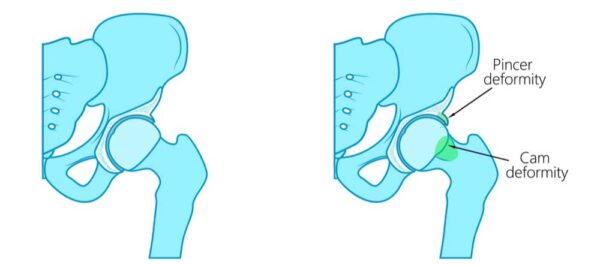Femoroplasty (Cam Impingement Treatment)/ Femoroacetabular Impingement (FAI) Surgeon

Are you an athlete who participates in sports activities requiring repetitive motion of the hip? If so, you may be at risk of Femoroacetabular impingement, otherwise known as FAI. FAI is a condition marked by abnormal contact between the hip bones causing impingement and pain. Hip surgeon and FAI treatment specialist, Dr. Jeff Padalecki provides diagnosis and both surgical and nonsurgical treatment options for patients in Austin who are experiencing symptoms and pain caused by FAI. Contact Dr. Padalecki’s team toady!
Femoroplasty as a Cam Impingement Treatment
Femoroacetabular impingement, otherwise known as FAI, is a condition marked by abnormal contact between the hip bones, and commonly affects young and middle-aged adults who are involved in repetitive sports. The ball (femoral head) can impact the socket (acetabulum) and lead to degeneration within the joint. Depending on what part of the hip has a bony abnormality, FAI has different names. Cam impingement involves the femoral head (ball). In these cases, the ball is not round and cannot rotate smoothly inside the acetabulum (socket), leading to a bump on the edge of the femoral head and cartilage degeneration. In severe cases of cam impingement, Austin, Round Rock, and Cedar Park, Texas communities orthopedic hip surgeon, Dr. Jeff Padalecki may recommend a surgical cam impingement treatment called a femoroplasty.
Cam impingement involves the femoral side of the hip joint and results when the abnormally shaped femoral head is forced into the socket. This abnormal fit can cause damage to the articular cartilage and the labrum. Many patients diagnosed with FAI have a mixed type, showing symptoms and traits of both cam and pincer (involving the acetabular side of the hip joint) impingement.

Dr. Padalecki will assess if the patient’s cam impingement can be treated using non-operative measures after conducting a thorough examination. Non-operative measures typically involve rest, activity modification and a physical therapy program to strengthen the hip’s core muscles. Injections may also be used for diagnostic and therapeutic purposes. A surgical cam impingement treatment may be recommended by Dr. Padalecki to correct the bony abnormality if a patient continues to have ongoing hip pain.
How is a Femoroplasty Performed?
Dr. Padalecki will perform arthroscopic hip surgery to correct cam impingement if surgery is needed. A femoroplasty is performed when cam impingement is present. This procedure consists of removing the bony abnormality (cam lesion) on the femur and reshaping the femoral head and neck junction into a normal sphere. Cases of mixed type impingement may require both a femoroplasty and an acetabuloplasty (pincer impingement treatment), which can be performed during the same surgery.
Patients will be placed on a rehabilitation program prescribed by Dr. Padalecki consisting of physical therapy immediately following cam impingement treatment. During therapy, patients will work on regaining strength and hip motion while protecting any repairs. Patients are encouraged to utilize crutches for 3 – 8 weeks depending of what type of procedure was necessary. The majority of patients are also placed in a brace to protect the hip during the healing process. The results from femoroplasty (with labral repair if needed) have been very promising. Many patients are satisfied with the procedure, have improvements in pain and return to their normal activities.
For additional resources on the surgical treatment of cam impingement, or for more information on femoroplasty, please contact the Austin, Texas orthopedic practice of Dr. Jeff Padalecki, hip surgeon.